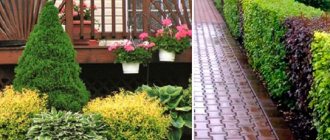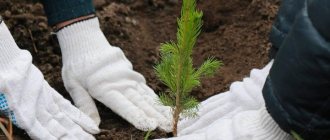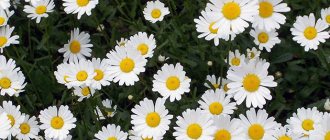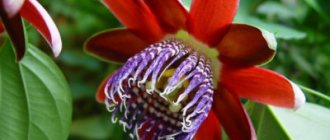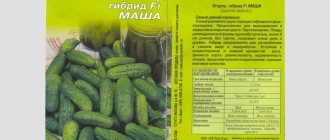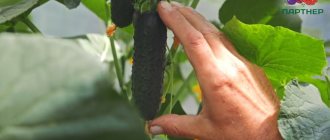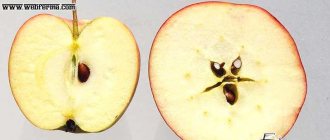I have long wanted to plant something original on my property. Everyone in our family loves raspberries, and blackberries are also very healthy. Previously, it was difficult to imagine a plant with such a name. But nowadays, planting raspberries is a common thing. So I finally planted the Loganberry variety and was very pleased with the result. I purchased several seedlings from the nursery. Now I enjoy the aroma and pleasant sweet and sour taste of large dark berries, reminiscent of raspberries. Today I’ll tell you how to grow the Loganberry variety: how to plant and care for the plant.
Breeding history: hybridization of raspberries and blackberries
In the 19th century, the term “hybridization” was coined. It involves crossing different types of crops to produce a new plant. Hybrids will inherit their appearance from their progenitors, but acquire a new aroma and resistance to disease. Also, in hybrid crops, most varietal qualities are retained (berry shape, bush density, etc.).
The Loganberry variety was bred in 1889 in the United States. Judge James Harvey Logan, who enjoyed breeding in his free time, once planted the Auginbaug blackberry variety and the Red Antwerp raspberry variety next to each other.
As a result of cross-pollination, the fruits ripened, from the seeds of which bushes with beautiful bright berries grew. This new unusual variety was named "Logan berry", or in other words, Loganberry.
Did you know? Loganberry is the first hybrid variety, descended from raspberries and blackberries. Before its appearance, no one thought about crossing these similar cultures.
Planting and caring for Loganberry blackberries: photos, videos and reviews
I have long wanted to plant something original on my property. Everyone in our family loves raspberries, and blackberries are also very healthy. Previously, it was difficult to imagine a plant with such a name. But nowadays, planting raspberries is a common thing. So I finally planted the Loganberry variety and was very pleased with the result. I purchased several seedlings from the nursery. Now I enjoy the aroma and pleasant sweet and sour taste of large dark berries, reminiscent of raspberries. Today I’ll tell you how to grow the Loganberry variety: how to plant and care for the plant.
Characteristics and description
The height of the Loganberry raspberry bush reaches 2 m. The long branches bend strongly, so the bushes must be formed and tied to trellises annually. The shoots may be covered with thin spines, but in most cases they are absent.
Light pink flowers appear in mid-June. They are collected in brushes of 15–25 pieces. The leaves are large, gray-green in color. The lower plate of the leaf has a silvery tint. There is a small amount of roughness on the surface of the sheet.
Advantages and disadvantages
- The advantages of the Loganberry variety include the following characteristics:
- good harvest;
- pleasant taste and presentation;
- absence of thorns on the shoots;
- ease of care;
- resistance to diseases and pests;
- the ability to use bushes for decorative purposes.
- If we consider the disadvantages of the variety, they are as follows:
- the need to form and garter the bush;
- low winter hardiness.
Did you know? In the 12th century. In England and Scandinavia, blackberries were used for pagan rituals, as they were considered a magical berry. These berries were also often used to dye fabrics.
Optimal region and climate
It is necessary to grow the Loganberry raspberry variety in regions with a warm climate. During the selection process, it was not possible to make the crop frost-resistant, since the ancestors did not have such characteristics.
When the temperature drops to -15°C, the bushes die. The climate of the region should be moderate, so this variety is planted, as a rule, in the Moscow region and the southern regions of the country.
Features of fruiting
The culture belongs to the varieties of medium-late ripening period. Fruiting occurs in mid-August. Since the berries do not crack or fall off, they can be collected before frost sets in.
Some gardeners do not have time to collect ripe raspberries before the first frost. Therefore, they pick the berries along with the stalks and store them in a warm and dark room. After 2–3 weeks, the fruits will ripen on their own.
Read how to properly plant and grow raspberries.
Characteristics of berries
Consider the description of the fruits of the Loganberry raspberry variety:
- berry shape - cone-shaped;
- length - up to 4 cm, and diameter - 2 cm;
- average unit weight - 8 g;
- raspberry-colored fruits;
- the taste is pleasant, sweet.
The berries inherited their dimensions from blackberries, and their taste and shade from raspberries. Loganberry can be used to make desserts, jams, compotes and even tinctures. The fruits are also suitable for fresh consumption, nourishing the human body with useful microelements and vitamins.
Productivity
The yield of the Loganberry variety is high. With high-quality care, you can collect up to 13 kg of products from 1 bush. The harvest largely depends on the quality of watering, fertilizing and the formation of shrubs.
If you do not have the opportunity to regularly care for the plants, the harvest will be only 5 kg per plant. You have the right to decide for yourself whether to carefully care for your raspberry or not.
Video: Emalina Loganberry
Reviews
Egor
When I bought the seedlings, the seller advised me to plant them at a distance of 3 - 4 meters from each other and cut the shoots so that they were 20 - 25 cm from the ground. I also learned that the plant loves light, and if you plant it on the sunny side, there will be more berries. I was pleased with the harvest a year later, since the ovary is formed on last year’s shoots. The fruits are sweet, but with a slight sourness. Watered only in extreme heat, loosened the soil under the bushes and fed them. Ezhemalina is resistant to diseases, I have not had any cases of infection. I recommend to everyone.
Valentina
I planted Loganberry a couple of years ago because a neighbor let me try it and really liked it. The plant is undemanding, but it is important to water it on time so as not to dry it out and fertilize it periodically. To improve yields, I mulched the surface with humus and collected the fruits along with the stalk. The berries are perfect in taste; I like to eat them fresh. But I also make compotes, jam, and also dry and freeze them so that I can later make filling for baked goods.
Landing Features
The quality and quantity of the harvest depends on proper planting. Experienced gardeners have already learned by heart the basic rules for planting raspberry and blackberry varieties. If you have never grown such a crop before, then there is nothing difficult about it - all the stages are similar to the standard procedures for planting raspberries and blackberries.
Deadlines
In the Moscow region, the optimal planting time is early October, and in the southern regions the planting period is extended until November. Consider the climate conditions in your area. The plant must have time to take root and prepare before the onset of cold weather.
Some gardeners prefer spring planting. If you are inclined to this option, then try to plant the bushes before the sap begins to flow in the shoots - if the buds open, planting will negatively affect the plant, and you will not be able to harvest this year.
There are situations when planting is carried out in the summer. In this case, the seedlings are planted on a cloudy day, preferably rainy. The plant should not be allowed to remain in the scorching sun for a long time. This negatively affects its growth and fruiting.
Find out also about the features of the cherry-cherry hybrid (Duke).
Choosing a suitable location
When planting the Loganberry variety, it is necessary to take into account a number of requirements for the planting site:
- The soil should be loose and fertile. The crop cannot be planted in swampy areas - it does not tolerate waterlogging of the soil.
- Groundwater should be at a depth of 2–3 m.
- It is recommended to plant seedlings in sunny areas next to barriers (walls, bushes, trees). Such structures or plants will help protect the plant from drafts.
Selection and preparation of planting material
High-quality planting material is the basis for a good harvest. Seedlings must be selected carefully so that the shoots and roots are not affected by diseases and parasites. The optimal height of planting material is 50–70 cm. The size of the root system should be 30 cm.
It is better to make purchases in nurseries rather than in markets - this way you will be confident in the quality and originality of the chosen variety.
Before planting, seedlings must be prepared. Immediately after purchase, their roots are soaked in a solution of potassium permanganate (1 tablespoon per 2 liters of water). This will allow disinfection and destruction of all bacteria. Keep the plants in a manganese solution for no more than 1 hour, otherwise the protective bark on the roots may be damaged.
After this, it is worth soaking the root system of the seedlings in the Kornevin solution (30 g per 5 liters of water) for 2 hours. This drug stimulates the growth of the crop. After the specified time, you can begin planting in open ground.
We recommend studying raspberry crop rotation on an open ground plot.
Landing algorithm
The planting technology consists of the following steps:
- Prepare a hole for planting. Its dimensions should be 50×50×50 cm. Mix the excavated soil with humus in a 1:1 ratio.
- The distance between seedlings should be 1 m, and between rows - 2 m.
- Carefully place the planting material inside the hole and straighten the roots.
- Fill the hole with nutritious soil, leaving the root collar above the ground.
- Water the bushes with 20 liters of warm water.
Plant on loose soils
Planting and care:
- although Loganberry is an unpretentious plant, it grows better on loose and fertile soils;
- needs sun and protection from the wind;
- It is better to plant along fences or walls of the house.
- It is better to plant bushes in rows at a distance of 80 cm from each other and up to 2 meters between rows;
- use trellises or tall stakes for gartering;
- when using planting material with a closed root system, try not to damage the earthen ball;
- sprinkle the plants with soil consisting of sand and peat;
- After planting the seedlings, they should be cut to a height of 25-30 cm, watered well and the soil mulched.
The soil should be loose and fertile. Photo: i0.wp.com
The crop grows well along the fence.
Photo: i1.wp.com Planting dates:
- in central Russia, it is better to plant raspberries in the fall, a month before the onset of cold weather, so that the plants have time to adapt and take root;
- You can plant bushes in the spring, but before sap flow begins;
- some gardeners plant seedlings in the summer, but on hot days it does not take root well and requires special care.
In autumn, cut out all fruit-bearing shoots. Photo: chto-posadit.ru
Feeding and pruning:
- the first fertilizing is carried out 3 years after planting, adding manure under the roots at the rate of 5 kg per 1 sq.m;
- During the flowering and fruiting period, the plant needs potassium-phosphorus fertilizers: per 1 sq.m. you will need 2 kg of superphosphate and potassium sulfate;
- after harvesting, cut off the fruit-bearing branches, leaving woody and green shoots of this year;
- mulch the soil high with rotted manure, it will protect the root system from freezing and serve as good fertilizing
Tie the bunches and lay them in rows for further coverage. Photo: i2.wp.com
Preparing for winter:
- remove shoots from the trellis and tie them into a bundle. Bend it to the ground, securing it with metal staples;
- Cover the top of the lash with spruce branches and wrap it with agrofibre;
- leave vents on the sides, which should be opened during the thaw period for ventilation
Care
In order to harvest a large and high-quality harvest every year, it is necessary to properly care for the bushes and the area. The most important stage of care is feeding. It is necessary to apply 4 times per growing season. In the spring, before the start of sap flow in the shoots, add 10 liters of ammonium nitrate solution (300 g per 10 liters of water) to each plant.
When the first flowers appear, it is necessary to water the area with a humus solution (5 kg per 10 liters of water). 30 liters are poured per 1 m². In mid-July, the plants are fed with a solution of potassium nitrate (500 g per 10 liters of water). For 1 bush use 5 liters. The last feeding is carried out at the end of September using superphosphate (100 g per 5 liters of water), at the rate of 10 liters per 1 plant.
Watering is carried out every week. 20 liters of warm water are poured under each raspberry bush. If you live in regions where the air temperature is constantly high (from +30°C and above), then use 30 liters of water.
After irrigation, it is necessary to loosen the top layer of soil - this will prevent a crust from forming on the ground, and the root system will receive the necessary amount of air. Weeds should be removed as needed; this procedure is considered reliable protection against pests.
Plants are pruned in spring and autumn. In March, after the snow melts, you need to cut off all frost-damaged branches, and in the fall, remove diseased and dry shoots, which will only provoke dryness over the entire area of the bush.
The formation of a bush consists of removing the lower shoots that lean heavily against the ground. If this is not done, they will rot, which will increase the number of pathogenic bacteria.
A necessary stage of care is garters. To do this, drive 2 stakes into the ground (one is installed on one side of the bush, and the second on the other). Wires or ropes are stretched horizontally between them at a height of 70 cm from the ground. Long shoots that bend towards the ground are tied to stretched ropes. To do this, use fabric tapes or thick threads.
Loganberry hybrid - brief description
This hybrid can be called one of the most popular varieties. It is planted quite often and has the highest characteristics. Where did this variety come from and how did it get into our garden?
History of appearance
- Let's start by defining such a culture as Ezhmalina. This is a hybrid that takes from blackberries a high level of productivity, undemanding soil composition and care, and from raspberries it gets non-thorny stems and resistance to cold winters.
- According to one version, the variety was obtained in the 19th century (1889). In the United States, a judge and amateur breeder named Logan was engaged in growing commercial fruit varieties and planted the Auginbaug blackberry bush and the old Red Antwerp raspberry bush nearby. This gardener planted the seeds, and a hybrid grew with large red berries, which was named Logan berry or Loganberry.
- Then Ezhmalina began to gain more and more popularity. Subsequently, other hybrids appeared, such as: Boysen's raspberry (Boysen berry), Young's berry (Young's berry), Taybury (obtained in England and is also quite popular among gardeners). In Russia, I.V. Michurin was involved in the selection of this crop in the first half of the last century.
Botanical description
Indeed, the bush took the most valuable qualities from raspberries and blackberries. Many gardeners use the bush as a hedge; in July, elongated shoots appear - lashes, which are not so prickly and are subsequently covered with bright green foliage and tasty large berries.
- The decorative qualities of the Ezhmalina are excellent. Also, the fruits are much larger than raspberries and the taste is richer. Productivity is also excellent, and resistance to frost makes it possible to grow shrubs in any region.
- The Loganberry variety is a shrub about 1.7 - 2 m high, the branches are long and have a curved structure. This form requires the installation of a trellis and a garter. Plant growers recommend installing trellises of such a design that during the winter months they can be laid on the soil and covered along with the shrubs.
- In the second decade of June, the flowering period begins, which is presented in the form of small flowers of a light pink hue. The flowers look spectacular against the background of light green dense foliage. Flowers are collected in brushes of 15 - 20 pieces.
- The harvest ripens in mid-August, and the fruits can be harvested almost until frost. Fruiting is uneven and extended, which allows you to enjoy raspberries for a fairly long period.
- The most delicious and juicy berries are the first ones. They are large and have a wonderful sweet taste and shiny surface. The weight of one fruit is about 10 grams. With good care, it is possible to collect 10 - 12 kg of berries from one plant. A more modest harvest is also possible if you do not devote a lot of time to the bush - 4 - 5 kg per plant.
The berries are used fresh and for making preserves, jams, and blended wines. Extracts are also included in medicines. The composition of raspberry fruits includes such valuable and useful substances as calcium, sulfur, phosphorus, iron and organic acids.
Preparing for winter
Based on reviews, the Loganberry raspberry variety has low resistance to frost. Therefore, it is necessary to annually prepare the bushes for the coming winter, so that next season you can again enjoy tasty and healthy berries.
Check out also
How to prepare raspberries for wintering: terms, rules, stages Watering with superphosphate, which is carried out in September, is not only the application of fertilizers.
A properly prepared solution (30 g of substance per 5 liters of water) helps to create a protective barrier on the soil surface through which frost is difficult to penetrate.
For greater protection, you need to mulch the tree trunk circle: mix straw and humus in equal proportions and lay it in a 30-cm layer around the trunk.
In the central regions of the country, an additional procedure for preparing for winter will be required, which consists of shelter.
To do this, the shoots should be bent to the ground and the entire bush should be covered with plastic film. It is necessary to make small holes in the shelter so as not to provoke the development of fungi.
Growing and caring for raspberries
Landing
Important! Raspberry fields are planted in sunny areas without drafts. On loose, moisture-absorbing soils. We must not forget that the crop will tolerate drought, but may die from excess moisture.
Planting can be done both in spring and autumn. But we must remember that in the north and in the Moscow region, plants will not be able to take root before frost sets in. Typically, gardeners in southern latitudes do planting in the fall. It is possible in the summer, but there should be more soil on the roots of the bushes.
Reproduction methods
There are several ways to propagate the Loganberry variety:
- Green cuttings. In August you need to cut off the upper parts of the shoots. Their length should be at least 25 cm. After this, place the cuttings in a container with water for 10–14 days. During this time, small roots will form. Plant new seedlings in the soil, deepening them by 20 cm. Next year, an adult plant will form.
- Root cuttings. In the spring, dig up the roots and select those that are 10 mm long. Divide into parts and plant in holes, the depth of which is 20 cm. The roots will give rise to new growth
Important! You can't propagate raspberries by seeds. Since this crop is a hybrid, this method blocks the parental varietal properties, and they are not transferred to the new plant.
Propagate by seeds and cuttings
Stages:
- select complete, intact seeds without damage. To do this, fill them in a jar with water, mix and take only those that have settled to the bottom for planting;
- Dry the selected seeds, wrap them in linen and place them in a freezer tray;
- from January to February, stratify the seeds. Place them in a bag of damp sand and dip it in damp sawdust or moss. Periodically moisten the sawdust and knead the sand with the seeds;
- in April, sow seeds in a box of soil;
- at the end of May, grown seedlings can be planted in a summer greenhouse by installing a temporary film shelter on it, and in the fall the finished seedlings can be planted in a permanent place
Stages:
- young green shoots must be cut off at the root. Divide each shoot into parts, leaving 2-3 buds on each. Carefully cut green leaves in half;
- place the prepared cuttings in a growth stimulator for 2-3 hours and prepare the soil for planting. Mix peat, wood ash, sand with soil, water well and plant the cuttings at an angle of 45 degrees. Cover the plantings with film or glass jars. Monitor soil moisture;
- When the cuttings take root and shoots form from the buds, the planting material is ready for transplanting
Stages:
- bend the young shoots to the ground. Secure the top of the head with a staple and cover it with earth;
- Water abundantly so that the growths take root;
- By autumn, young bushes can be separated from the mother bush
Diseases and pests
The following diseases can be found on bushes of the Loganberry raspberry variety:
- powdery mildew;
- anthracnose;
- verticillium wilt.
To treat powdery mildew, use soda ash. When you detect the first signs of this disease, immediately water the bushes with a solution of this product (100 g of the drug per 10 liters of water). This will protect neighboring plants from the development of the disease.
It is recommended to use a solution of copper sulfate (20 g per 10 liters of water) against verticillium wilt. Bordeaux mixture is used against anthracnose (100 g per 5 liters of water). Spraying is carried out 2 times a month.
Among the pests of this shrub, weevils and raspberry beetles should be highlighted. To combat parasites, use folk remedies such as ammonia or whey.
To prepare a solution of ammonia, use 1 bottle of the drug and dilute it in 10 liters of water. To prepare a solution from whey, just mix 5 liters of warm water and 2 liters of product. Spray the beds every month.
Prevention of diseases and pests consists of timely removal of weeds, loosening the soil and watering. The less attention a crop receives, the faster its immunity will deteriorate.
Important! Stop using any chemicals to combat diseases and parasites 20 days before harvesting.
—
otherwise the fruits will absorb all these substances.
Tayberry
Also a raspberry variety, but Scottish. We crossed Aurora blackberries and raspberries.
Culture with thorny bushes up to 2 meters.
Dense red berries, large, sweet, crimson, weighing 5 - 12 g.
From 4 to 5 kg are collected from one bush.
The first wave of the Tayberry harvest appears in early July, and you can enjoy this berry until August.
This works out to about 5 harvests per season.
Resistant to diseases and pests.
Tolerates cold, but it is better to cover.
Doesn't like drafts. Grows well in sunny areas.
Harvesting and storage
Loganberry is harvested in cloudy weather so that the berries do not wither in the sun. To collect raspberries, small plastic containers are used in which the products will be stored. Each filled container should weigh no more than 1 kg, otherwise the fruits will choke.
Berries should be stored in a cool place. The best option is a refrigerator. In such conditions, the products are stored for 20 days. To increase shelf life, you need to freeze the fruits in the freezer or make jam.
Hybrid raspberry-blackberry varieties are characterized by ease of care and at the same time high yields. Both experienced summer residents and beginners can grow Loganberry raspberries. You only need to know the basic rules of agricultural technology for this plant.
Suitable for garden decoration
Ezhemalina Loganberry - description of the variety:
- Loganberry or boysenberry is a hybrid, thornless, medium-ripening variety. The harmonious combination of the blackberry bush and the raspberry taste of the berries can serve not only for harvesting, but also as a wonderful decoration for the garden. Shoots reach a height of up to 5 m and require high garter. Can serve as decoration for arched structures that look very decorative.
- The bush blooms with large white flowers almost all summer - from June to September. Fruiting begins from the end of July until frost. The productivity is high, from one 3-year-old bush you can collect 5-7 kg of fragrant fruits, from older bushes you can collect up to 10 kg of berries.
- The berries are large, bright red in color with a bright raspberry flavor and a blackberry note in the aftertaste. The drupes are densely located to each other, the seeds are small, and do not cause any unpleasant sensations when eaten. The pulp is juicy, tastes sweet and sour. The length of each berry is 4 cm, weight is 5-7 g.
- Especially does not require close care , but needs reliable shelter for the winter. Tolerates drought and high temperatures well. It is weakly resistant to diseases, so it requires preventive treatments.
The author of the story claims that Loganberry blooms and bears fruit throughout almost the entire growing season, producing annual shoots with flowers from replacement buds. It is characterized by high yield, better taste and greater growth:
Selection of seedlings
Growing Tayberry is not at all difficult, and care will not take much time. Before you start planting, you need to choose healthy and high-quality seedlings. It is better to purchase them in large shopping centers for gardeners or in special nurseries that breed such plants.
When purchasing, first of all pay attention to the root system and buds. The roots should be healthy, elastic and dense, without signs of pest damage or rotting. A dry and sluggish root system indicates that the bush has been poorly cared for, so it is unlikely to be able to take root in a new place.
There should be at least 3 buds at the base of the seedling. They are the ones who will produce young shoots a year after planting. The readiness of a plant for active growth is determined by the presence of formed stems.
It is worth paying attention to the packaging. Seedlings cannot be kept in polyethylene, as they may die from too high humidity. It is better to opt for bushes wrapped in light fabric.
You should not try to choose a larger plant with a lush crown; such seedlings do not take root well. If the plant is not planted in open ground immediately after purchase, it is necessary to wrap the root system with a piece of damp cloth. But it cannot be kept in this form for long, as the roots may rot. It is better to plant the bush in the ground as quickly as possible.
